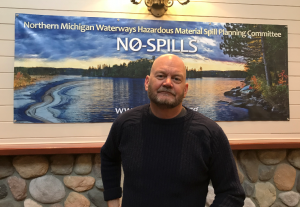
Experts gather in Traverse City
At the 28th Annual “No Spills” Conference January 3 through the 5th, emergency responders throughout the Great Lakes Region gathered to discuss ways to protect the Great Lakes from spills of all kinds and discussed new ways to respond in the event of a hazardous material spill that would affect the Great Lakes and its tributaries.

Steve Keck, Chief of Contingency Planning and Force Readiness for the United States Coast Guard, courtesy of Mary Ellen Geist
Steve Keck is the Chief of Contingency Planning and Force Readiness for the United States Coast Guard, Sector Sault Ste. Marie. He gave the keynote at the conference in Traverse City.
He talked about the careful planning and teamwork involved in getting ready for any kind of spills in the Great Lakes.
Keck took the position in 2010. Since that time, he has planned out and enacted many exercises simulating emergency response to a hypothetical oil spill coming from the Line 5 Pipeline in the Straits of Mackinac. In fact, it is mandatory to carry out a simulation of an emergency response to a Line 5 spill once a year.

Underwater image of Line 5, courtesy of michigan.gov
The Line 5 Pipeline, owned by Enbridge Inc., runs 4.5 miles across the Straits of Mackinac between Michigan’s Upper and Lower Peninsula. It carries approximately 23 million gallons of oil and gas a day from Superior, Wisconsin to Sarnia, Ontario. It has been in operation since 1953.
A University of Michigan study released in 2016 predicts at least 700 miles of shoreline along Lake Michigan and Lake Huron could be damaged by oil in the event of a worst-case scenario spill from Line 5.
One of the biggest challenges, says Keck: responding in the event of a spill in icy winter conditions. But Keck says after each exercise, new technologies and practices are identified.
He says the 2012 winter exercise was extremely useful and prompted Enbridge to purchase a wealth of new technology that will now be on hand for any emergency involving an oil spill.
Keck says,” We don’t do exercises to show how good we are. We do exercises to identify the gaps.”
Keck says one of the most exciting new technologies that will make a big difference: remote operated vehicles (“ROV’s”) that can be sent underneath the ice to do surveillance and even be involved in oil clean-ups. He says infra-red radar can help detect the location of oil spills, too.
Keck says, “We do not operate in a vacuum.” The exercises often involve 40 agencies and more than 700 people representing state and federal agencies, academics, state and local police and many more groups of people that would respond to a spill ,in addition to the U.S. Coast Guard.
The good news: Keck says the emergency responders in the area are ready. The bad news: right now, 40 percent recovery of spilled oil is considered the best rate possible.
Another emergency exercise will be held later this year.
Check out my interview with Keck, below.
For more information about the No Spills Conference, go to no-spills.org
Note from Great Lakes Bureau Chief Mary Ellen Geist: greatlakesnow.org is in production on a forthcoming documentary about the Line 5 Pipeline called “Beneath the Surface: The Line 5 Pipeline in the Great Lakes” which will air in April 2018 on PBS. You’ll be hearing more about this documentary in the coming weeks. Check your local PBS affiliate for more information.
1 Comment
-
“Keck says one of the most exciting new technologies that will make a big difference: remote operated vehicles (“ROV’s”) that can be sent underneath the ice to do surveillance and even be involved in oil clean-ups. He says infra-red radar can help detect the location of oil spills, too.”
Someone please tell me that no one believes that an oil spill under six feet of ice in the straits can be mitigated and cleaned up by remote control under water “drones”. The catastrophic effects of large oil spills cannot even be eliminated in tropical waters or where there is no ice cover.
And even if they could, at the very least, detect a spill under the ice, why would anyone with half a brain let it get that far when all you have to do is shut the damn pipeline down and stop investing in energy resources that are soon going to be irrelevent and obsolete anyway?




